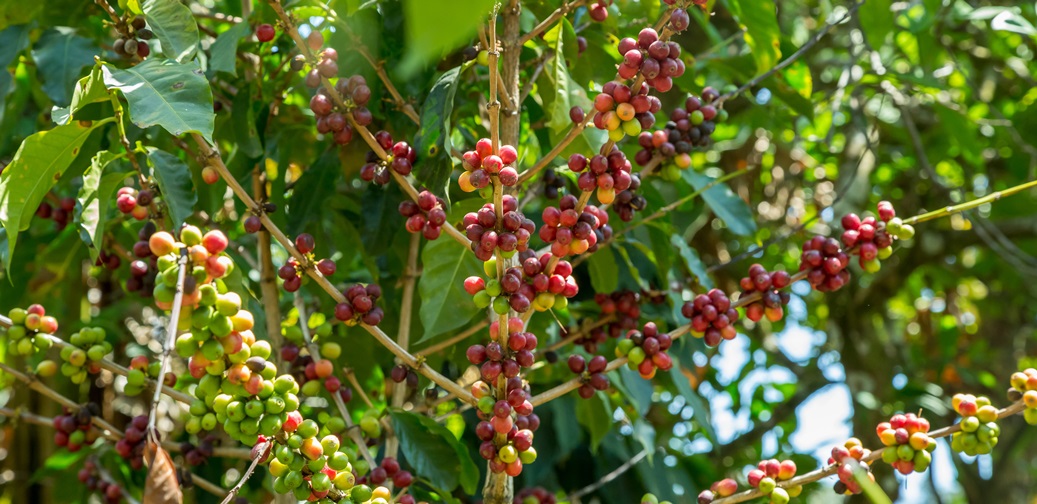A new research paper reveals that the pulp of coffee “cherries” (the fruit that surrounds the bean we all know and love) can give its own kind of jolt to reforestation and ecological restoration projects.
This finding is of particular personal interest to me (Storm Cunningham). My wife, Dr. Maria MacKnight, and I spent a month on a coffee farm in the gorgeous town of Boquete in northern Panama, close to the Costa Rican border.
One day, after the crop had been harvested, we went out and gleaned the field, finding more than enough leftover ripe berries for our own use. I manually shucked the beans (the pulp is surprisingly slimy), sun-dried them, and roasted them in our oven. We then enjoyed the freshest-ever—and incredibly delicious—coffee for a couple of weeks.
Naturally, I dumped the pulp back on the coffee field. Now, with this new research, I know it was the right thing to do.
Here’s the Introduction from the paper:
The use of organic waste to accelerate forest succession has received some recent attention from the restoration community (Choi et al., 2018; Treuer et al., 2018). Nutrient‐rich agricultural by‐products, including fruit peels, pulp and other non‐market vegetable material, have been proposed as additives to ameliorate barriers to tropical forest recovery on degraded land (Choi et al., 2018; Daily & Ellison, 2002; Janzen, 2000). Given ambitious global objectives to restore large areas of forest (i.e. Bonn Challenge, UNFCCC Paris Accords), and the projected expenses of these activities, cost‐effective restoration strategies that maximize multiple benefits are desirable (Brancalion et al., 2019). Linking agricultural industries to forest restoration through the use of non‐market products would represent one such win–win scenario.
While agricultural by‐products have been used to promote tree growth in forestry settings, actual trials in a restoration context are few. The most well‐known study was carried out in northern Costa Rica in 1998 when scientists at Área de Conservación Guanacaste (ACG) reached an agreement with an orange juice company, Del Oro S.A., to dispose of several thousand tons of orange waste on ∼3 ha of degraded abandoned pasture (Janzen, 2000). The results of this non‐replicated study showed spectacular improvements in soil properties and aboveground woody biomass relative to the untreated control plot (Treuer et al., 2018). While the ambitious goal to restore >100 ha of degraded pasture in the ACG was upended by a well‐publicized lawsuit by a rival orange juice company, ostensibly over concerns from environmental impacts of the orange waste in a national park (Escofet, 2000), the potential use of agricultural by‐products in restoration settings has remained tantalizingly promising but largely untested.
Depositing a rich organic material on degraded lands such as abandoned tropical pastures has the potential to overcome multiple barriers to forest recovery. Introduced pasture grasses and ruderal vegetation that dominate pastures can effectively prevent establishment of native woody plants and arrest succession (Holl, 1999). Soils in old pastures are also often highly degraded due to compaction and loss of nutrients which can impede establishment and growth of trees (Davidson et al., 2004). Putting a thick layer of organic material on pastures is likely to eliminate grasses via asphyxiation and increase soil nutrient content, thus creating better conditions for the establishment of naturally dispersed tree seeds.
One readily available agricultural by‐product in the tropics is coffee fruit pulp. Coffee is produced in over 60 countries globally (Esquivel & Jimenez, 2012; ICO, 2014). Processing of green coffee beans for market involves separation of the seed from components of the fruit, including the skin (exocarp), pulp (mesocarp) and mucilage (parenchyma). The residual coffee ‘pulp’, which comprises >50% by weight of the coffee harvest, is commonly treated as a waste product and heaped into storage lots where it is left to decompose (Ferrell & Cockerill, 2012; Sanchez et al., 1999).
Coffee pulp is nutrient rich containing high levels of carbohydrates (35%), crude protein (10.8%) and lignin (31.5%) and has a pH ∼4.25 and a C:N of ∼46.3 forming a valuable compost (Janissen & Huynh, 2018; Orozco et al., 1996). While alternative uses of coffee pulp can include animal feed (Núñez et al., 2015), pharmaceutical products (Prata & Oliveira, 2007) and organic mulch and fertilizer (Rathinavelu & Graziolsi, 2005), these uses remain undeveloped in many tropical countries where the pulp is typically discarded or minimally processed via composting to reduce environmental and health hazards (Echeverria & Nuti, 2017; Ferrell & Cockerill, 2012). Globally, an estimated 218,400 tons of fresh pulp and mucilage must be managed at coffee processing sites for every million 60‐kg bags of dried coffee produced for market (Echeverria & Nuti, 2017; Rangarajan, 2019).
In this single‐site case study, we evaluated the application of unprocessed coffee pulp sourced from local coffee cooperatives to restore degraded pasture in southern Costa Rica. Based on the earlier success with orange waste to recover forest on abandoned pastures in northern Costa Rica (Treuer et al., 2018), and studies quantifying major barriers to forest regeneration in this region (Holl, 1999; Holl et al., 2020), we anticipated that application of coffee pulp would (1) eliminate introduced pasture grasses through asphyxiation; (2) improve soil conditions by creating a rich organic layer; and (3) create conditions for rapid colonization by early‐successional trees.
Photo via Adobe Stock.

